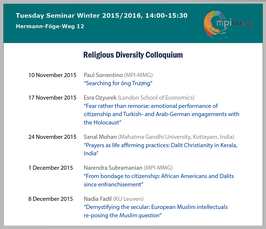"Economies of Sao Paolo: Image, Space, Circulation"
Religious Diversity Colloquium Spring 2016
- Datum: 24.05.2016
- Uhrzeit: 14:00 - 15:30
- Vortragende: Maria José de Abreu (Institute for Cultural Inquiry, Berlin)
- De Abreu studied Anthropology of Media at SOAS, University of London, and received her PhD in Sociocultural Anthropology at the University of Amsterdam in 2009. Her work engages with a range of anthropological, philosophical and literary debates about religion, time, space, personhood, the human senses and their technological extensions. She is currently working on two projects. The first is on the flourishing of Byzantine imaginary in urban Sao Paolo through the practices of a media-savvy religious movement and the seconds is on experiences of impasse among Portuguese youth in the context of the Southern European financial crisis. She has published in various journals and edited volumes. She is currently affiliated to the ICI-Berlin Institute for Cultural Inquiry. In 2017 she will be both a fellow at Humboldt University and an assistant professor at the department of Anthropology at Columbia University in the city of New York.
- Ort: MPI-MMG, Hermann-Föge-Weg 12, Göttingen
- Raum: Conference Room

For more details please contact vdvoffice(at)mmg.mpg.de.
This talk analyzes how the Byzantine icon of Theotokos ( Mother of God) became the model for an architectonic project, a Catholic sanctuary, in the city of São Paulo, Brazil. The study is situated against the historical background of the so-called “Holy War” (Guerra Santa) in the mid-nineties when contestations over the image opened the path for the dissemination of Eastern orthodox Christian iconographic repertoires in Brazil. Underlying historical and plastic connections between Byzantine iconography, techno-mediatic Pentecostalization and neoliberal governance in urban São Paulo, the paper explores what Dr de Abreu identifies as a tendency to aniconic abstraction within contemporary urban Brazil. Such tendency is associated to two main intersecting undercurrents that are subservient to the political and economic interests of a time and a place. These are 1-) a critique of graphic representation and 2-) a renewed valorization of transparency as the ambivalent antidote to conspicuous corruption.